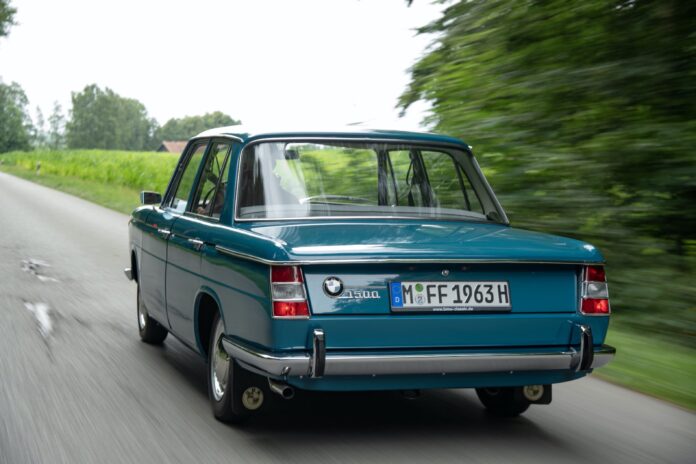
[ad_1]
BMW’s grand ambition within the coming years is the launch of the so-called “New Class,” slated to hit the market in 2025 with the following era of the electrical 3 Sequence. The “New Class” first appeared within the early Nineteen Sixties, and expectations for it have been equally excessive on the time. It marked the definitive ascent of the Bavarian automotive producer into the premium phase.
On the subject of BMW’s future plans, virtually the only focus is the New Class. Launched with the brand new 3 Sequence, it goals to be greater than only a singular automotive however somewhat a brand new platform that includes cutting-edge battery expertise, superior driver-assistance methods, and a modular building that permits quite a lot of physique types. Saloons, estates, coupés, convertibles, and SUVs—all with various wheelbases and monitor widths—comprise this New Class, and presumably extra.
When the BMW 1500, the primary mannequin of the unique New Class, made its world debut on the Frankfurt IAA within the autumn of 1961, the curiosity from attendees was super. This new mid-range mannequin from Munich was a game-changer, hardly anticipated by anybody beforehand. For BMW, the 1500 marked the beginning of a brand new future, as that they had grand ambitions to change into a real different to Mercedes: targeted on design, infused with a major dose of dynamism. Technologically, the BMW 1500 was a delight, and it seemed the half too. The automotive didn’t characteristic a prestigious inline-six engine however as an alternative a four-cylinder inline engine with 55 kW/75 HP, a five-bearing crankshaft, and an overhead camshaft. The chassis of the practically one-tonne midsize automotive provided entrance struts, angled longitudinal management arms on the rear, and entrance disc brakes that assured it might successfully decelerate from its prime pace of 150 km/h. The design had greater than a contact of Italian aptitude, much like the BMW 3200 CS, which was powered by a considerable V8 engine.
The BMW 1500 arrived on the excellent time, as Germany had left the conflict behind and was experiencing growing financial success, with residents having fun with rising buying energy. For the primary time, over 1,000,000 new autos have been registered in Germany per yr, and demand for bigger autos was higher than ever earlier than. The minimal price ticket of 9,500 Deutschmarks for the BMW 1500 made it the appropriate automotive for the period. Beforehand, BMW had provided fashions just like the small 700 alongside the big “Baroque Angel.” The New Class was thus a programmatic assertion, coming after high-profile however low-volume fashions just like the BMW 503/507 had ceased manufacturing within the late Fifties and after BMW had narrowly escaped being acquired by Daimler. What was lacking for financial revitalisation was the appropriate automotive: the 1500.

Buyer curiosity within the midsize automotive, initially referred to internally because the “Mittelwagen,” was substantial, resulting in round 25,000 pre-orders for the brand new mannequin by early 1962. For the design, then-BMW design chief Wilhelm Hofmeister had consulted Giovanni Michelotti. Following its world premiere, there have been a number of minor design tweaks and an influence enhance to 59 kW/80 HP on account of barely elevated compression. Driving the BMW 1500 revealed that the four-door midsize saloon provided not solely beneficiant inside area and a big boot but additionally moved somewhat briskly due to a kerb weight of round 950 kilograms. Such driving pleasure within the early Nineteen Sixties was provided maybe solely by smaller fashions from England or Italy, not a midsize German saloon, which additionally shined when it comes to its frivolously Italian-influenced design. Regardless of all its sporty magnificence, the 1500 was extra fuel-efficient than most of its opponents. The 53-litre gas tank allowed for ranges of round 500 kilometres, whereas nonetheless attaining a prime pace of 150 km/h.
At the moment, not solely the engine however notably the dealing with set new requirements within the mid-range class. Improvement Chief Fritz Fiedler and Check Director Eberhard Wolff have been accountable for combining a strut entrance axle with longitudinally mounted rear wheels for the primary time, which have been 14 inches in measurement somewhat than the initially deliberate 13 inches. Anybody who values spirited driving will nonetheless recognize this at this time.

Subsequently, it was hardly shocking that the New Class shortly made the soar into motorsports. In 1963, the BMW 1500 developed right into a household of more and more sporty autos with the stronger siblings 1800 and 1800 ti. Above the 90 HP BMW 1800, the 1800 ti was positioned for notably demanding prospects, particularly these overseas.
The highest mannequin, due to elevated compression to 1:9.5, two Solex twin carburettors, bigger consumption valves, stiffer valve springs, a camshaft with prolonged valve timing and better cams, produced 81 kW/110 HP at 5800 rpm. A bigger, ribbed aluminium oil pan with a five-litre capability ensured good oil cooling—excellent circumstances for entry into touring automotive racing. Particularly designed for motorsports was the BMW 1800 TISA, which featured bucket seats, adjustable sports activities suspension, a five-speed gearbox, a 105-litre gas tank, and an influence enhance to 96 kW/130 HP, making it able to 192 km/h. Gross sales have been restricted to licensed sports activities automotive drivers. For BMW, the New Class of the Nineteen Sixties was a monumental success. Munich hopes for the same end result with the brand new electrical era, set to premiere in just below two years.

[ad_2]
